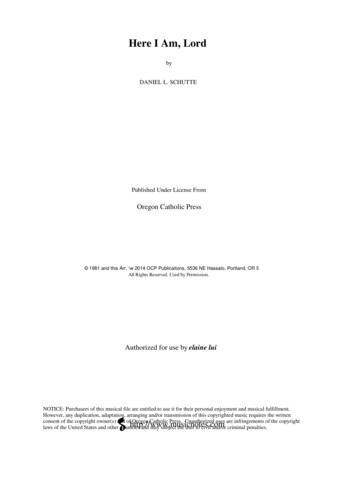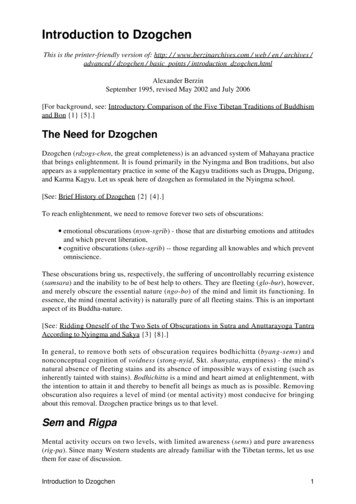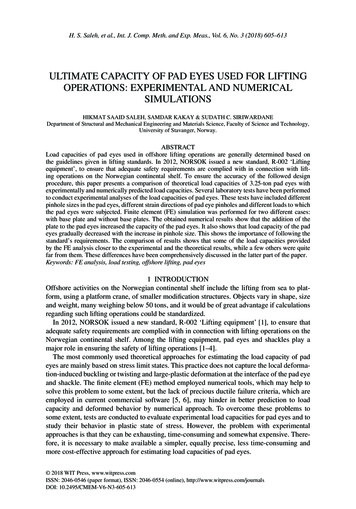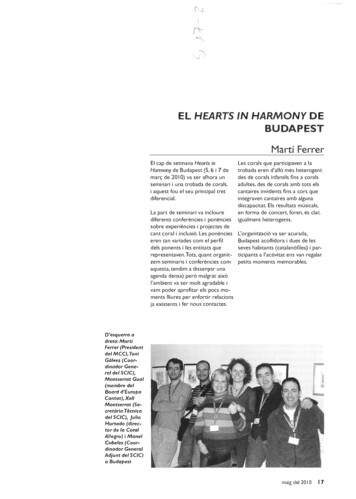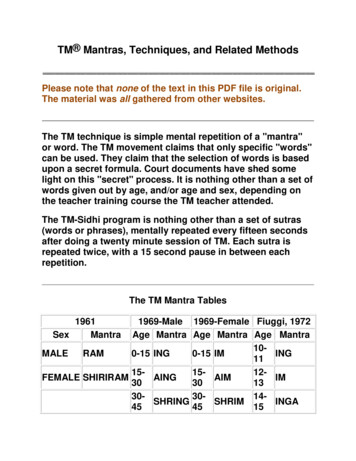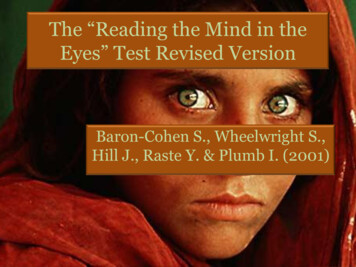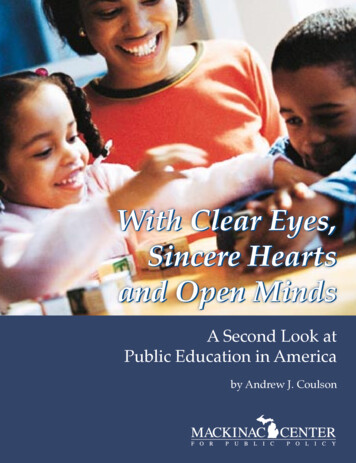
Transcription
Mackinac Center for Public PolicyWith Clear Eyes,Sincere Heartsand Open MindsA Second Look atPublic Education in Americaby Andrew J. CoulsonWith Clear Eyes, Sincere Hearts and Open Minds1
Mackinac Center for Public PolicyThe Mackinac Center for Public Policy is a nonpartisan research and educational organizationdevoted to improving the quality of life for all Michigan citizens by promoting sound solutions to state and local policy questions. The Mackinac Center assists policy makers, scholars,business people, the media, and the public by providing objective analysis of Michigan issues.The goal of all Center reports, commentaries, and educational programs is to equip Michigancitizens and other decision makers to better evaluate policy options. The Mackinac Center forPublic Policy is broadening the debate on issues that have for many years been dominated bythe belief that government intervention should be the standard solution. Center publicationsand programs, in contrast, offer an integrated and comprehensive approach that considers:All Institutions. The Center examines the important role of voluntary associations,business, community and family, as well as government.All People. Mackinac Center research recognizes the diversity of Michigan citizens andtreats them as individuals with unique backgrounds, circumstances, and goals.All Disciplines. Center research incorporates the best understanding of economics,science, law, psychology, history, and morality, moving beyond mechanical cost/benefitanalysis.All Times. Center research evaluates long-term consequences, not simply short-termimpact.Committed to its independence, the Mackinac Center for Public Policy neither seeks nor acceptsany government funding. It enjoys the support of foundations, individuals, and businesses whoshare a concern for Michigan’s future and recognize the important role of sound ideas. TheCenter is a nonprofit, tax-exempt organization under Section 501(c)(3) of the Internal RevenueCode. For more information on programs and publications of the Mackinac Center for PublicPolicy, please contact:Mackinac Center for Public Policy140 West Main StreetP.O. Box 568Midland, Michigan 48640(989) 631-0900 Fax (989) 631-0964www.mackinac.org mcpp@mackinac.org2With Clear Eyes, Sincere Hearts and Open Minds
Mackinac Center for Public PolicyWith Clear Eyes,Sincere Hearts andOpen MindsA Second Look atPublic Education in Americaby Andrew J. CoulsonJuly 2002 2002 by the Mackinac Center for Public Policy, Midland, MichiganPermission to reprint in whole or in part is hereby granted, provided that theMackinac Center for Public Policy is properly cited.ISBN: 1-890624-28-4SP2002-03With Clear Eyes, Sincere Hearts and Open Minds3
Mackinac Center for Public PolicyAbout the AuthorAndrew J. Coulson is the Mackinac Center for PublicPolicy’s senior fellow in education policy. Andrew isauthor of the book, “Market Education: The UnknownHistory,” available from Transaction Publishers. Priorto joining the Center, he was a senior research associate at the Social Philosophy and Policy Center in Kentucky. He has written numerous articles and essaysfor academic journals and for newspapers includingThe Wall Street Journal and The Seattle Times.4With Clear Eyes, Sincere Hearts and Open Minds
Mackinac Center for Public PolicyWith Clear Eyes, Sincere Hearts and Open MindsA Second Look at Public Education in AmericaIby Andrew J. Coulsont is time to take a second lookat public education in America.Not individually or combatively,as we have so often in the past, butcollectively and cooperatively. It istime we recognized that whateverour disagreements in the ongoingeducation debate, our goals, in theend, are the same. As a nation, weall cherish the ideals that every childshould have access to a good education, that school should not onlyequip students for success in privatelife but also for participation in publiclife, and that our education systemshould help us to build strong andharmonious communities.Yes, there is disagreement as tohow well our schools are performing,and how they might be improved,but the fact that they are not livingup to our ideals is undeniable.Critics from all across the politicallandscape have rightfully lamentedour failure to provide our poorest andmost disenfranchised children with aquality education. Our shortcomingsin preparing students for the modernworkplace are well known to thenation’s job seekers and employers.Sparse voter turnouts, civic disengagement among young Americans,and students’ lack of knowledge ofour nation’s history and institutions,are regularly lamented. We cannotsweep under the rug the fact thatpublic school parents are frequentlythrown into conflict with one anotherover everything from curriculumand methods to sex education andschool prayer.These are grave problems, yetwe allow them to fester for generation after generation. The hostilityand distrust that pervade educationpolicy discussions have poisonedour ability to work together towarda solution. This cannot continue. Ourchildren are too important.So, please, let us forget our politics, put aside our preconceptions,and acknowledge a simple fact: Thepeople working in education do sobecause they love children. And ourdearest wish is to secure for the nextgeneration an education worthy ofthat love. If we can manage to ceasehostilities for a while, we just may beable to make that wish a reality.With Clear Eyes, Sincere Hearts and Open Minds1
Mackinac Center for Public PolicyClear EyesHere as elsewhere, the shortestpath to a solution begins with a soberunderstanding of the problem. Howand where are we falling short of oureducational ideals? To what degree?In attempting to answer these questions we must be unflinching. Glossing over imperfections in our presentsystem of education will only delayor prevent their correction. At thesame time, it should be clear that thepoint is not to ascribe blame to individuals. Our educators are as goodand as dedicated a group of peopleas can be found in any profession,and even if we were to swap themfor an entirely different workforcetomorrow, it would do nothing toaddress whatever flaws may existin the system’s design.Our greatest problem, and yetthe one whose magnitude we mostoften underestimate, is our astonishing failure to serve low-income andminority children. According to themost recent International Adult Literacy Survey, one quarter of 16- to25-year-old Americans cannot reador write well enough to understand abus schedule, let alone put togethera resume or read a newspaper.1 Wehave condemned one quarter of ouryoung men and women to remain onthe periphery of society, locked them2out of most gainful employment, andshut them off from the joy and solaceof the written word. Of these tens ofmillions of young people, a disproportionate number come from pooror minority families.2Every day, all over the country,countless other children also areshortchanged. There is the childwho, for any of a number of reasons, lags behind his age-matesin math or science. This studentis nonetheless pushed ahead yearafter year, to spare him the stressof being “flunked.” Instead of reassessing the system that would inflictsuch trauma, we turn away from thischild’s growing frustration and confusion with the subject matter and hislack, at each successive grade, ofthe underlying knowledge necessaryto grasp his current assignments. Itis as a result of this “social promotion” that barely literate, barelynumerate students can be graduated from high school, ill-equippedto deal with the modern world.On the other end of the spectrum is the little girl who beginsavidly reading horse stories in heradolescence and leaps quicklyahead to ever richer, more sophisticated works of literature. By the timeshe reaches high school, she yearnsto be engaged by more challengingWith Clear Eyes, Sincere Hearts and Open Minds
Mackinac Center for Public Policydiscussions and would profit fromreading great works of literature.Sometimes this spark is kindled intoan educational blaze, with classestailored to her advanced abilities.Too often, though, it is allowed tofizzle instead by a system designedto serve a mythical “average” student rather than meet the variedneeds of the individual children in itscare. How much do we lose when wefail to fan these sparks of excitementand love of learning? How much doour children lose?And what of the great teachers? Those who, year after year,elicit from their students achievements no one thought possible?Those who devise new ways ofconveying a deep and lastingunderstanding of their subjects? Atbest, we try to identify a handful ofthem, handing out awards for recognition of a job well done. And there itends. Many more top teachers laborin relative anonymity, known onlyto the their immediate colleaguesand students. Even those identified on the state or national levelare seldom given the opportunityto broadly disseminate their successful techniques, or to designnew lesson plans for use by vastnumbers of students.This indifference to excellentteaching has caused a staggering educational and cultural lossto ourselves, our children and ourgrandchildren. Imagine a worldwhere penicillin, electricity, andmodern agricultural techniquesnever spread beyond the handfulof individuals who developed them.Conversely, imagine a world wherethe best educational materialsand techniques were continuallysearched for, identified, and madewidely available; where untestedfads could not gain or keep afoothold, and where improvementswere constantly sought for even themost soundly proven and effectivemethods. Our inability to bring theremarkable progress evident in somany areas of human life to thefield of education, and especiallythe inability to get the best educational methods and materials to allthe students who need them, has apainful and ever-mounting cost.Conversely, how can we tolerate the annual pageant in whichineffective teachers are shuffledfrom one school to another, ratherthan being helped to improve ordismissed? Though job securityis a valuable asset in attractingpeople to the teaching profession,it is impossible to justify the socialcost of keeping teachers who fail toWith Clear Eyes, Sincere Hearts and Open Minds3
Mackinac Center for Public Policyperform adequately year after year.Four out of five teachers agree thatit must be made easier to fire theirincompetent peers. 3 They knowthat even though these individualscomprise a small portion of the totalworkforce, on a national level theyimpede the educational progress ofcountless children.Finally, we must not forgetthe vitriolic conflicts that haverelentlessly beset our educationsystem. Though the “school wars”of the past century are sometimesthought to be inevitable in a freeand democratic nation, or even tobe embodiments of that freedomand democracy, these views ringhollow. Our religious diversity isno less than our diversity of educational interests and preferences,and yet we have managed to buildone of the most peaceful heterogeneous religious communities in theworld. No, our constant bickeringover curriculum, methods, schoolprayer, sex education, and thelike are not integral parts of education in a free society. They areevidence that we have yet to finda harmonious way for Americansto pursue their shared educationalgoals while also carrying on theirvaried traditions and meeting theirunique needs.4Sincere HeartsThe problems with our education system are thus broader anddeeper than we usually admit. Dowe care? Do we really care, in aheartfelt, personal way, what happens to the millions of boys andgirls that emerge from high schoolunable to read simple texts? Do wecare about the children who loseconfidence because we push themrelentlessly from one grade to thenext, whether or not they have mastered the material? Does it botherus to think of all the brilliant youngminds whose excitement about science or literature fades for lack ofencouragement? Do we have the willto finally end our balkanizing battlesfor control of public education?If we answer yes to thesequestions, we must act. More thanthat, we must take effective action—because with genuine caring comesgenuine commitment. It is notenough just to empathize with ourchildren’s educational plight. Noris it enough to jump on the firstreform bandwagon that rolls by,hoping it will do some good. If wereally care about our kids we mustbase our reforms on reason andevidence. Unless we make everyconceivable effort to get results,we betray our children and reduceWith Clear Eyes, Sincere Hearts and Open Minds
Mackinac Center for Public Policyour commitment to an exercise infeel-good futility.These are our kids. Their problems are our problems. We have tobuild them a better system of education. We must throw open our mindsto an honest appraisal of past andpresent, and to an unconstrainedvision of the future.Open MindsBut though we must be prepared to consider entirely newapproaches to public education,it would be foolish to ignore theexperiences of the past. Dedicatedreformers have been doing their bestto address our educational problemsfor decades, and while the problemspersist, we can learn much from thereformers’ efforts. Among the moststrongly advocated and widely implemented ideas have been: increasingspending, shrinking classes, nationalizing curriculum and testing, creating “model schools,” and allowing“school choice.” Let us look brieflyat each in turn.Increasing SpendingYou’ve heard the expression, “you get what you pay for?”The fact that better products andservices usually cost more thaninferior ones has conditioned usto assume that the same patternholds true for anything, includingeducation. Increasing our expenditures on public schooling has thusbeen seen as a promising way toimprove its quality since the birth ofthe institution some 150 years ago.Though it’s difficult to trace spendingpatterns that far back, we do havemore recent statistics. What thosefigures show is that we now spendroughly five times more per pupil peryear than we did in 1950, in real,inflation-adjusted dollars.4Many factors have contributedto this rise. Children now spend moredays in school per year, schools offera wider variety of programs, schoolbuildings are larger and more expensive, there are many more teachers,administrators and non-teachingstaff per student than there oncewere, salaries have grown, and,in recent decades, the number ofstudents classified as learning disabled (and hence eligible for specialservices) has skyrocketed.5Yet, this tremendous growth inthe apparatus of public schooling,and the corresponding dramatic risein its cost, has not ended a history ofstagnation and decline in academicachievement during the last threequarters of a century. Yes, a motivated researcher can find five- orWith Clear Eyes, Sincere Hearts and Open Minds5
Mackinac Center for Public Policy15-year spans during which scoreson a particular test went up or stayedthe same. But when the most reliable measures of student achievement trends are taken together, theypoint at best to stagnation, and atworst to a steady deterioration ofscholastic achievement over thepast 70 years. The most alarmingevidence of a decline has been in themost important skill of all: reading.6This finding is sadly consistent withthe already cited International AdultLiteracy Survey, in which nearlyone in four Americans ages 16 to25 scored at or below the Survey’slowest level of literacy.7The accuracy of this pictureis corroborated by numerous otherresearch findings and examples atthe state and district levels. Over theyears, many studies have comparedhow well students in higher-spending public schools performed compared to their peers in lower-spending schools. The overall conclusionhas been that higher spending is notsignificantly associated with higherachievement. 8 Even researchersinitially skeptical of this conclusionhave found it to be true: Higherpublic school spending generallydoes not help children learn more.9Indeed, some of the mosttroubled, lowest performing dis6tricts in the country are also amongthose spending the most money.Baltimore, Hartford and Washington, D.C., for example, all spendupwards of 9,000 per pupil annually (the national average is about 7,000), yet are plagued by poortest scores and decaying facilities.Between the late 1980s and thelate 1990s, Kansas City, Missouribecame the highest spending district in the country, adding well over 1 billion to its existing budget inobedience to a court ordered reformplan. Despite this unprecedentedinfusion of funds, overall studentachievement did not improve, andthe judge responsible for the ordereventually rescinded it, acknowledging its failure.Nor is the United States alonein this problem. Recent researchon the performance of educationsystems in the 29 nations belonging to the Organization for EconomicCooperation and Development(OECD) finds a similar consistentpattern of declining educationalproductivity.10Please understand that thisis not to say that higher spendingis never helpful. There certainlyare cases where additional publicschool expenditures have yieldedbenefits. The conclusion that weWith Clear Eyes, Sincere Hearts and Open Minds
Mackinac Center for Public Policyare forced to draw from the evidence is only that these cases arethe exceptions, and that they areoutweighed by the more numerouscases in which more money didnot equal more learning. Howevermuch we would like to believe thatwe could transform our schools justby digging a little deeper into ourpockets, this notion simply does notstand up to scrutiny.It has often been noted thatour public school system is notable to make consistently effectiveuse of the funds it receives. Whenmany districts around the countryare unable even to maintain theirbuildings in a reasonable state ofrepair despite adequate funding,it should come as no surprise thatgreater funding has not improvedthe far more difficult task of studentlearning. 11 If we hope to improveour educational outcomes withhigher spending, we will first haveto change the system in such a waythat we can be assured the moneywill be spent wisely.Shrinking ClassesFew education reforms receiveas much public approval as reducingclass size. At least 21 states haveadopted class-size-reduction programs since 1984. 12 Washingtonstate voters passed a ballot initiative to further the cause in 2000.And Congress voted in 1999 to setaside 1.2 billion dollars to subsidize such programs. California alonededicated an additional 1.5 billionto shrink classes from just under 30to 20 students.13 Teachers, too, aresolidly behind class-size reduction.The American Federation of Teachers supports significant class-sizereduction,14 and the National Education Association (NEA) has a goalof reducing all classes to 15 or fewerstudents.15Does reducing class size produce the kind of improvement weseem to expect? It certainly seemsreasonable to assume that the moreattention teachers can focus on eachstudent, the better students will do.Unfortunately, what seemsreasonable in theory doesn’t alwayshold true in practice—that’s why wedo studies. Recently, the journalPsychological Science in the PublicInterest published a very thoroughinvestigation that sifted throughthe reams of available literatureon the subject.16 After poring overdecades-worth of research, theauthors concluded that very littlecan be said with regard to higherachievement as a result of smallerclasses. Very tentatively, they sug-With Clear Eyes, Sincere Hearts and Open Minds7
Mackinac Center for Public Policygest that reducing class size to 15students may improve test scores inkindergarten and possibly the firstgrade. Though that gain persists inlater years, no added benefit seemsto be achieved from reducing classsize beyond this point.In other words, there is reasonto believe that reducing class size inkindergarten and perhaps the firstgrade may do some good, but inolder grades there is no evidencethis will improve achievement.And even such a weak endorsement is qualified by the study’sauthors, who warn that class-sizeachievement effects may not begeneralizable to other schools andstudents.It seems that we have thrownour support behind smaller classesnot because of the evidence, butbecause they seem like a goodidea, and because they are lesscontroversial and easier to implement than alternative reforms(if sometimes more expensive).Shrinking class sizes across theboard allows us to feel like we’redoing something to help our kids.But if we really care about solvingthe serious educational problemsaffecting all our children, we willhave to look beyond our feelingsand ask what truly works.8NationalizingCurriculum and TestingUntil the mid 1800s, educationin the United States was local. Virtually all decisions were made at theschool level, whether the schoolsoperated independently or wererun by local government.A chief argument for the creation of our modern state-levelschool systems was that the centralization of decision-making in thehands of experts would usher in anew era of more effective teachingmethods and materials, and thuslead to significant improvement instudent achievement. These samearguments are heard today, thoughit is now widely suggested thatstandards and testing should bedirected by the federal government.In a May 2001 survey, 78 percentof Americans supported nationallystandardized tests.17Is our support for nationalizingcurriculum and testing justified? Oris it another example of somethingthat seems like it ought to work butreally doesn’t? There are a couple ofways to answer that question. Mostobviously, we can look at how wellthe move to state-level curricula andtesting have played out.One of the most decisiveexamples was California’s adoptionWith Clear Eyes, Sincere Hearts and Open Minds
Mackinac Center for Public Policyof a new statewide reading instruction curriculum in 1987. The adoption process was very much whatone might expect, with curriculumdesigners from all over the country being solicited to submit theirproposals, and a state committeeof education experts selecting thewinner from among them. It wasthe same sort of process by whichmany other curriculum- and textbook-selection decisions are madearound the country.Over the next several years,reading scores on the CaliforniaAssessment Program declinedsteadily. Seven years into thenew reading program, California’sfourth-grade reading scores on theNational Assessment of EducationalProgress (NAEP) had fallen to deadlast in the nation.Though some suggested thatthis abysmal showing might be dueto the state’s high immigrant population or other demographic factors,the evidence indicated otherwise.In fourth grade reading, California’swhite students—when consideredseparately from their minority counterparts—scored worst in the nationin reading. The state’s Hispanicstudents also scored worst, and itsblack students were second worstin the nation.What had gone wrong? As ithappened, the education experts onthe state curriculum committee hadselected a program that eliminatedstructured, synthetic phonics, thepractice of systematically teachingchildren to read words by soundingout their constituent parts and thenblending those sounds together. Evidence showing the great importanceof phonics in early reading instruction was already well establishedbefore the committee membersmade their decision.18So why did the committee’sexperts reject all the instructionalprograms that adhered to the consensus of reading research? Wishful thinking. Structured, teacherdirected methods of instructionrun counter to the philosophy thathas held sway in teacher trainingprograms for more than 70 years.Education philosophers and theorists, those who have guided thecurriculum in colleges of educationfor a century, espouse a naturalisticteaching philosophy that states alllearning is natural, and that structured, teacher-directed lessonsare stifling and harmful. So, whenit came time for a group of educators to choose a method of readinginstruction for California’s millions ofchildren, they eschewed structured,With Clear Eyes, Sincere Hearts and Open Minds9
Mackinac Center for Public Policyempirically proven phonics lessons,opting instead for the unproven butphilosophically appealing “wholelanguage” approach.To blame California’s rejection of effective reading instructionmethods on this committee wouldbe a terrible mistake. These werewell-meaning individuals doingwhat they thought, and what theyhad been taught, was right. Thereis no reason to think that an entirelydifferent group of people would nothave made the same choice, in spiteof the evidence in favor of phonics.The problem was not with thepeople involved, but with the systemin which they operated. If there hadbeen a mechanism in place thatwould have encouraged committee members to heed the mostreliable research, and that wouldhave strongly tied their own professional futures to student outcomes,then and only then could this committee, and the next, and the next,be expected to consistently makesound decisions.The case of California is notunique. It is just one episode in along history of arbitrary curriculumand textbook selection decisionsmade by well-meaning expert educators. Occasionally their decisionshave been good ones; more often10they have been dubious or evendisastrous.19Dismayed by the lack of evidence mustered by supporters ofcentralized curriculum guidelines,Columbia University researcherRichard M. Wolf decided to compare the results of the nationsparticipating the Third InternationalMathematics and Science Study todetermine whether or not havingnational achievement standardscorrelated with higher achievement. They didn’t. Though most ofthe participating countries did “havea national curriculum or syllabus,”Wolf wrote, there was “virtuallyno relationship between studentperformance and having a nationalcurriculum or syllabus.”20The 150-year-old predictionthat centralizing power over thecurriculum in the hands of expertswould ensure sound pedagogicaldecisions has been proved false byhard, sad experience. Centralization of authority doesn’t provide anincentive structure that consistentlyforces educators to heed researchevidence and to focus on outcomesrather than on idealized notions ofhow children should learn.The record of state testing programs is equally troubled. A greatbody of evidence has been amassedWith Clear Eyes, Sincere Hearts and Open Minds
Mackinac Center for Public Policyover the past decade pointing towidespread corruption in these programs. High-stakes test results arereferred to in the scholarly literatureas “polluted” and “contaminated” byfraud and are considered to be virtually useless as measures of actualstudent achievement. The problemranges from occasional outrightcheating by teachers and principalsto inflate student scores, to themore common practices of “teaching to the test” and of preventingpotentially low-scoring studentsfrom taking the tests.These problems occur all overthe country, from Michigan21 to California,22 from suburban Connecticut23to central Chicago,24 and everywherein between. By far, the most tellingevidence of cheating comes frompublic-school educators themselves.A 1992 survey asked 2,256 teachers, principals, testing coordinatorsand superintendents from aroundthe country whether their colleaguesengaged in blatant cheating. Fortyfour percent said yes. 25 Fifty-fivepercent of the teachers surveyedwere aware of flagrantly unethicaltesting practices such as changingstudent’s answers, teaching specifictest items in advance of the test, andgiving hints during the test. Thehigher the stakes associated with aparticular test, the greater the incentive to massage its results.Apart from the fact that highstakes tests have become unreliablemeasures of student achievement,there are other reasons to be apprehensive about them. Unbeknownstto most education reformers, highstakes national testing programsare not a recent idea. More than acentury ago, England put in place asystem whereby schools were paidbased on the number of studentspassing a set of government tests.Scientist T. H. Huxley observedat the time that this “Payment byResults” program “did not compelany schoolmaster to leave off teaching anything; but, by the very simpleprocess of refusing to pay for manykinds of teaching, it has practicallyput an end to them.”26Even when money is notdirectly at stake, evaluating schoolssolely on the basis of high-profiletests can have the same deleterious effects. As already noted, U.S.public schools already alter their curricula to fit the material they know tobe on state- or district-level tests.To the extent that a subject is notpart of a mandatory state curriculum or testing program, it is likely tobe marginalized. This trend is alsoevident in England under its currentWith Clear Eyes, Sincere Hearts and Open Minds11
Mackinac Center for Public PolicyNational Curriculum. According tothe National Association of HeadTeachers, the “obsession with passing tests in English, mathematicsand science [means] other subjects[are] being overlooked.”27Most of us agree on the importance of a thorough, well-designedcurriculum. And the public is solidlyin favor of academic testing as oneway to find out how much childrenare learning and how well schoolsare performing. But the benefits to bederived from mandatory imposition ofa particular curriculum or set of testsby state and federal governments arenot supported by the evidence.Creating “Model Schools”The past century has been filledwith efforts to create model schoolsor programs that embody recipes forsuccess. The assumption underlyingthese efforts has been that, if we canidentify a set of practices that workswell in one or more schools, it wouldor could automatically be made available to children everywhere. Let’slook at some of the most interestingattempts along these lines.The still famous educationphilosophe
It is time to take a second look at public education in America. Not individually or combatively, as we have so often in the past, but collectively and cooperatively. It is time we recognized that whatever our disagreements in the ongoing education debate, our goals, in the end, are the same. As a nation, we all cherish the ideals that every child

